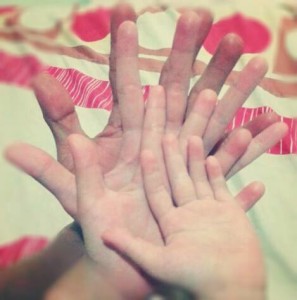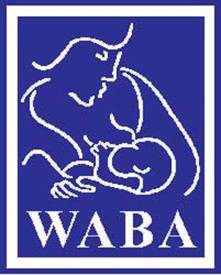Hands Up for Prevention
 WABA celebrates World AIDS Day on 1 December. We join the “Hands Up Campaign”1 to support early testing, diagnosis and treatment of all people living with HIV (Human Immunodeficiency Virus) in order to maximise prevention of both horizontal and vertical transmission of HIV which can lead to the Acquired Immunodeficiency Syndrome (AIDS).
WABA celebrates World AIDS Day on 1 December. We join the “Hands Up Campaign”1 to support early testing, diagnosis and treatment of all people living with HIV (Human Immunodeficiency Virus) in order to maximise prevention of both horizontal and vertical transmission of HIV which can lead to the Acquired Immunodeficiency Syndrome (AIDS).
Approximately 1.9 million adults worldwide have become infected with HIV every year for at least the past five years2. HIV affects mainly sexually active adults. A woman can be horizontally infected by her male sexual partner and then her babies and children can be vertically infected during pregnancy, during birth, or through breastfeeding.
Mothers living with HIV who adhere to their medications are recommended to breastfeed their babies exclusively for the first six months of life, followed by continued breastfeeding with appropriate complementary foods for up to two years or beyond3,4. Mixed feeding (combining breastfeeding with other foods and liquids) before six months of age has been shown to increase the risk of transmission through breastfeeding5,6. Replacement or formula-feeding increases the risk of mortality from infectious diseases and malnutrition7.
With increased coverage and improved medication regimens, rates of HIV transmission from mothers to infants have dramatically decreased. Since 1995, provision of anti-retroviral therapy (ART) to women living with HIV has prevented an estimated 1.6 million new paediatric HIV infections which would have been acquired through pregnancy, birth and breastfeeding. Well over a million infections (1.3 million) were prevented between 2010 and 2015. The largest decline was in the areas of the world previously worst affected, namely in eastern and southern Africa, where infections in infants fell three-fold, from 18% of infants in 2010 to 6% in 2015. By 2015, 91% of the 1.1 million women receiving antiretroviral medicines to prevent mother-to-child transmission were on lifelong antiretroviral therapy.
 Building on these findings, current global HIV and infant feeding policy has been designed to maximise HIV-free survival of infants and their mothers through routine early testing and prompt provision of ART. Pregnant women should have access to testing in early pregnancy and re-testing during late pregnancy and in the early postpartum period.5. HIV-exposed infants should receive early and repeat testing at birth, 6, 10 and 14 weeks8. Current research shows conclusively that careful adherence to maternal ART regimens during pregnancy and breastfeeding greatly reduces vertical transmission of HIV; and that exclusive and continued breastfeeding significantly improves overall HIV-free survival of babies3, 4. It is now recommended that mothers living with HIV should receive lifelong ART which not only protects their own health and permits them to enjoy a normal life-span, but also suppresses viral levels in their blood, and in their breastmilk, to undetectable levels9.
Building on these findings, current global HIV and infant feeding policy has been designed to maximise HIV-free survival of infants and their mothers through routine early testing and prompt provision of ART. Pregnant women should have access to testing in early pregnancy and re-testing during late pregnancy and in the early postpartum period.5. HIV-exposed infants should receive early and repeat testing at birth, 6, 10 and 14 weeks8. Current research shows conclusively that careful adherence to maternal ART regimens during pregnancy and breastfeeding greatly reduces vertical transmission of HIV; and that exclusive and continued breastfeeding significantly improves overall HIV-free survival of babies3, 4. It is now recommended that mothers living with HIV should receive lifelong ART which not only protects their own health and permits them to enjoy a normal life-span, but also suppresses viral levels in their blood, and in their breastmilk, to undetectable levels9.
WABA joins the Hands Up Campaign to support these life-saving initiatives. If the AIDS epidemic is to be ended by 2030, prevention efforts must be reinvigorated. With sufficient political will, further increases in child survival are within reach. In particular, all pregnant and breastfeeding women diagnosed with HIV, should be initiated on lifelong ART. Breastfeeding should be protected, promoted and supported for HIV-exposed babies. Furthermore the duration of breastfeeding should not be restricted. Improving women’s health so that they can continue to be vital and productive members of society, as well as care for their children adequately, is of crucial importance9.
Let’s all join hands to protect, promote and support breastfeeding for the best health outcomes for women living with HIV and their babies!!
For more information about please see:
What women need to know about breastfeeding in the HIV context
Read the statement in Chinese at muruhui.org
What women need to know about breastfeeding in the HIV context (Aarabic)
References:
- UNAIDS Hands Up Campaign
- UNAIDS 2016, Prevention Gap report
- Guidelines on HIV and infant feeding 2010 – Principles and recommendations for infant feeding in the context of HIV and a summary of evidence. Geneva, World Health Organization, 2010.
- WHO-UNICEF 2016, Guideline: Updates on HIV and Infant Feeding
- Coutsoudis A, Pillay K, Spooner E, Kuhn L, Coovadia HM. Influence of infant-feeding patterns on early mother-to-child transmission of HIV-1 in Durban, South Africa: a prospective cohort study. South African Vitamin A Study Group. Lancet. 1999 Aug 7;354(9177):471-6.
- Coutsoudis A, Pillay K, Kuhn L, Spooner E, Tsai W-Y, Coovadia HM for the South African Vitamin A Study Group. Method of feeding and transmission of HIV-1 from mothers to children by 15 months of age: prospective cohort study from Durban, South Africa. AIDS 2001;15:379-387
- Coutsoudis A, Coovadia HM & Wilfert CM, HIV, infant feeding and more perils for poor people: new WHO guidelines encourage review of formula milk policies, Bulletin of the World Health Organization 2008;86:210–214.
- Sherman G G. HIV testing during the neonatal period. Southern African Journal of HIV Medicine. 2015.
- WHO 2016, Consolidated guidelines on the use of antiretroviral drugs for treating and preventing HIV infection: recommendations for a public health approach– 2nd ed. ISBN 978 92 4 154968 4
- What women need to know about HIV and breastfeeding, WABA, November 2016
